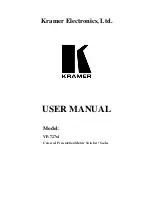
HDMI Input & Output Boards
105
Enova Digital Media Switchers - Hardware Reference Manual
Audio Troubleshooting
Before troubleshooting audio, it helps to understand how the system handles EDID information.
The source reads and adapts to the pre-loaded EDID on the DGX HDMI input connector.
The factory default EDID is set to support 2 channel L-PCM audio. This EDID can be modified by using one of the
methods described under "Possible Solutions" at the bottom of the page.
Audio Format Support on Enova DGX Boards
The following table indicates which audio formats are supported by specific Enova DGX boards.
*
Dolby Digital and DTS support up to 48 kHz, 5.1 channels.
NOTE:
DVI Boards must have their EDID changed to support HDMI signals with embedded audio.
IMPORTANT:
Because signals are routed through HDMI, 4K HDMI, DVI, DXLink Twisted Pair, and DXLink Fiber Boards which
feature SmartScale Technology, they normally produce a quality image. If the installation has special scaling, EDID, or
HDCP requirements, see page 140.
Problem
Solution
Audio is not passing through the Enova DGX 100 Series
Switcher, or is distorted.
The default EDID for input boards only supports 2 channel L-
PCM audio. If a sources chooses to ignore this EDID and send
a format that is not in the EDID, the audio may not pass
through the Enova DGX 100 Series Switcher at all or it may be
distorted.
To present other types of audio formats to the source, a different EDID
must be loaded (see EDID configuration on page 140).
If after changing the EDID on the input board, the audio is still distorted or
is not present on the destination device, then the device may not be
capable of supporting the requested audio format with the newly
loaded EDID setting. In this case, a standard EDID should be used and
the sources set up to only pass the type of audio that the downstream
destination devices can handle.
Note: One way to check if a destination supports a particular type of
audio format is to capture the EDID using the System Configuration
interface’s Save EDID function and then paste the data from the .edid
file into an EDID reader program (e.g., www.edidreader.com).
If you encounter audio problems, we recommend trying the following
solution:
Use the EDID Save and Load functionality in the System Configuration
interface (see page 141) to read the EDID from the destination device
and to write it to the HDMI input on the Enova DGX Switcher.
Audio not present or intermittent with good video.
A signal containing both video and audio must have space
for both signal portions. The audio signal portion lies in the
blanked portion of the video signal.
High Bit Rate Audio (HBRA) requires a larger than normal
space in the blanked area of the signal. Video formats with
reduced blanking normally provide enough space for audio
signals. In a signal that combines a video format with reduced
blanking and HBRA, the HBRA signal is truncated and can
present as either no audio or as problematic audio (static,
clicking, absent, etc.).
While Enova DGX hardware supports both HBRA and reduced
blanking video formats, these formats do not necessarily work
with one another.
Change either the audio format to non-HBRA or change the video
format to a format that does not use reduced blanking.
Audio Format Support on Enova DGX Boards
Audio Format
Bo
ard T
yp
e
s
HD
M
I / 4K H
D
MI
Inp
ut
Bo
a
rds
HD
M
I O
utp
ut
Bo
a
rds
DVI
Inp
ut
Bo
a
rds
DVI
Outp
ut Bo
ard
s
DXLi
nk
T
w
ist
e
d
Pa
ir
Inp
ut
a
nd Ou
tp
ut Bo
ar
d
s
DXLi
nk
F
ib
e
r
Inp
ut
a
nd Ou
tp
ut Bo
ar
d
s
Au
d
io
Sw
itc
hing
B
o
a
rds
(ASB and
ASB-DAN)
Audio
Insert/Extr
a
ct
Expansion Boar
d
s
(on ei
th
er the i
nput
or
th
e out
p
ut s
ide)
2 Channel L-PCM
•
•
•
•
•
•
•
•
6 Channel L-PCM
•
•
•
•
•
•
8 Channel L-PCM
•
•
•
•
•
•
Dolby Digital
•
•
•
•
•
*
•
*
DTS
•
•
•
•
•
*
•
*
Dolby TrueHD
•
•
•
•
DTS-HD Master
•
•
•
•
















































